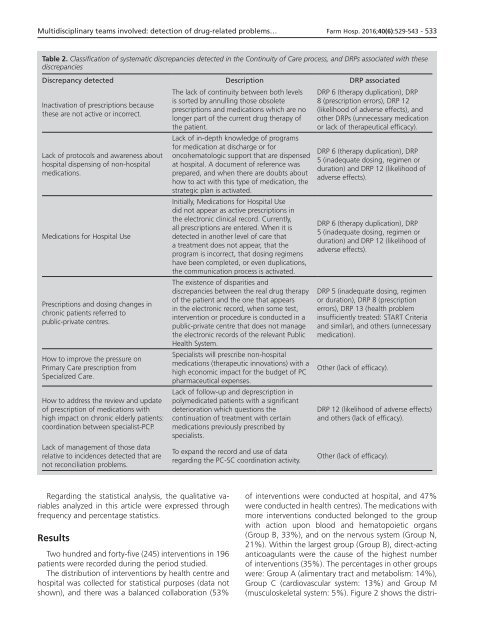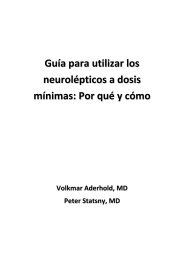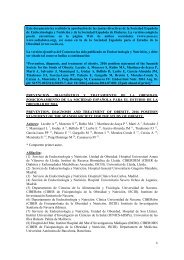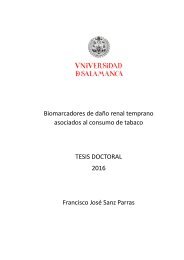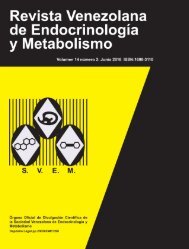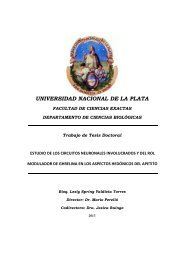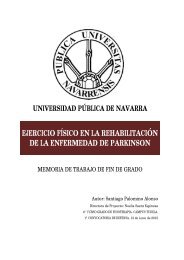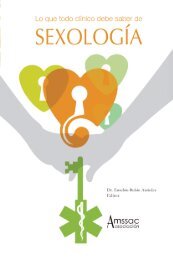Noviembre-Diciembre
156_v40n6(1)
156_v40n6(1)
Create successful ePaper yourself
Turn your PDF publications into a flip-book with our unique Google optimized e-Paper software.
Multidisciplinary teams involved: detection of drug-related problems… Farm Hosp. 2016;40(6):529-543 - 533<br />
Table 2. Classification of systematic discrepancies detected in the Continuity of Care process, and DRPs associated with these<br />
discrepancies<br />
Discrepancy detected Description DRP associated<br />
Inactivation of prescriptions because<br />
these are not active or incorrect.<br />
Lack of protocols and awareness about<br />
hospital dispensing of non-hospital<br />
medications.<br />
Medications for Hospital Use<br />
Prescriptions and dosing changes in<br />
chronic patients referred to<br />
public-private centres.<br />
How to improve the pressure on<br />
Primary Care prescription from<br />
Specialized Care.<br />
How to address the review and update<br />
of prescription of medications with<br />
high impact on chronic elderly patients:<br />
coordination between specialist-PCP.<br />
Lack of management of those data<br />
relative to incidences detected that are<br />
not reconciliation problems.<br />
The lack of continuity between both levels<br />
is sorted by annulling those obsolete<br />
prescriptions and medications which are no<br />
longer part of the current drug therapy of<br />
the patient.<br />
Lack of in-depth knowledge of programs<br />
for medication at discharge or for<br />
oncohematologic support that are dispensed<br />
at hospital. A document of reference was<br />
prepared, and when there are doubts about<br />
how to act with this type of medication, the<br />
strategic plan is activated.<br />
Initially, Medications for Hospital Use<br />
did not appear as active prescriptions in<br />
the electronic clinical record. Currently,<br />
all prescriptions are entered. When it is<br />
detected in another level of care that<br />
a treatment does not appear, that the<br />
program is incorrect, that dosing regimens<br />
have been completed, or even duplications,<br />
the communication process is activated.<br />
The existence of disparities and<br />
discrepancies between the real drug therapy<br />
of the patient and the one that appears<br />
in the electronic record, when some test,<br />
intervention or procedure is conducted in a<br />
public-private centre that does not manage<br />
the electronic records of the relevant Public<br />
Health System.<br />
Specialists will prescribe non-hospital<br />
medications (therapeutic innovations) with a<br />
high economic impact for the budget of PC<br />
pharmaceutical expenses.<br />
Lack of follow-up and deprescription in<br />
polymedicated patients with a significant<br />
deterioration which questions the<br />
continuation of treatment with certain<br />
medications previously prescribed by<br />
specialists.<br />
To expand the record and use of data<br />
regarding the PC-SC coordination activity.<br />
DRP 6 (therapy duplication), DRP<br />
8 (prescription errors), DRP 12<br />
(likelihood of adverse effects), and<br />
other DRPs (unnecessary medication<br />
or lack of therapeutical efficacy).<br />
DRP 6 (therapy duplication), DRP<br />
5 (inadequate dosing, regimen or<br />
duration) and DRP 12 (likelihood of<br />
adverse effects).<br />
DRP 6 (therapy duplication), DRP<br />
5 (inadequate dosing, regimen or<br />
duration) and DRP 12 (likelihood of<br />
adverse effects).<br />
DRP 5 (inadequate dosing, regimen<br />
or duration), DRP 8 (prescription<br />
errors), DRP 13 (health problem<br />
insufficiently treated: START Criteria<br />
and similar), and others (unnecessary<br />
medication).<br />
Other (lack of efficacy).<br />
DRP 12 (likelihood of adverse effects)<br />
and others (lack of efficacy).<br />
Other (lack of efficacy).<br />
Regarding the statistical analysis, the qualitative variables<br />
analyzed in this article were expressed through<br />
frequency and percentage statistics.<br />
Results<br />
Two hundred and forty-five (245) interventions in 196<br />
patients were recorded during the period studied.<br />
The distribution of interventions by health centre and<br />
hospital was collected for statistical purposes (data not<br />
shown), and there was a balanced collaboration (53%<br />
of interventions were conducted at hospital, and 47%<br />
were conducted in health centres). The medications with<br />
more interventions conducted belonged to the group<br />
with action upon blood and hematopoietic organs<br />
(Group B, 33%), and on the nervous system (Group N,<br />
21%). Within the largest group (Group B), direct-acting<br />
anticoagulants were the cause of the highest number<br />
of interventions (35%). The percentages in other groups<br />
were: Group A (alimentary tract and metabolism: 14%),<br />
Group C (cardiovascular system: 13%) and Group M<br />
(musculoskeletal system: 5%). Figure 2 shows the distri-


